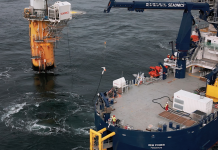When planning a wind plant, collector cable systems play a critical role in how efficiently power can be delivered from the point of generation to the grid. An optimal collector system design can help minimize electrical losses, cable and trenching costs and substation configuration costs. The new Wind Collector Optimization Service from GE’s Digital Energy business uses grid intelligence to help utilities, developers and contractors better plan the layout of their wind farm by providing an in-depth look at possible collector cable configurations and the benefits and drawbacks of each. With this information, system design can be optimized to reduce start-up costs and improve operational efficiency.
 Traditional manual collector cable design processes can be labor intensive, hard to adjust and can have long lead times. The result is a time-consuming, costly, non-optimized design with little flexibility to change the project after implementation has begun. GE’s new service provides customers with a collector system design that optimizes cable routing and sizing and addresses the challenges associated with traditional design methods. It provides customers in the wind renewable energy segment with a comprehensive optimization service — from initial consultation to a completed and validated design. The Wind Collector Optimization Service incorporates GE’s extensive experience in bringing over 4,000 MW of renewable energy online and more than 40 years of substation engineering, procurement, and construction expertise.
Traditional manual collector cable design processes can be labor intensive, hard to adjust and can have long lead times. The result is a time-consuming, costly, non-optimized design with little flexibility to change the project after implementation has begun. GE’s new service provides customers with a collector system design that optimizes cable routing and sizing and addresses the challenges associated with traditional design methods. It provides customers in the wind renewable energy segment with a comprehensive optimization service — from initial consultation to a completed and validated design. The Wind Collector Optimization Service incorporates GE’s extensive experience in bringing over 4,000 MW of renewable energy online and more than 40 years of substation engineering, procurement, and construction expertise.
“With our new Wind Collector Optimization Service, we meet with customers early on in the process to establish what features and parameters are important to them and are required for their specific project,” said Bob Turko, general manager of GE’s High Voltage Solutions business. “From there, we utilize our leading, proprietary design tool — which includes multi-variable analysis — to design an optimized wind plant collector system, reducing the design cycle time and lowering the total cost of ownership for our customers.”
With GE’s Wind Collector Optimization Service, the optimal route is determined between the turbines and the substation resulting in improved efficiency and a more resilient network. The solution provides a preliminary cable table with the ampacity of each collector circuit outlined in an easy-to-view, mapping file that can be viewed using Google Earth. In addition, the service includes trenching and cable cost estimates and provides insight into how efficiency can be improved through reduced power losses, optimized designs of cable sizes and trenching path configurations.
Using this optimization software, GE can reduce the cost of rationally designed collector systems, providing potential savings of greater than 20 percent while also reducing design cycle times by 60 percent.
— Source: GE Digital Energy



























